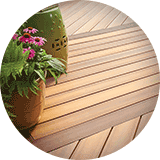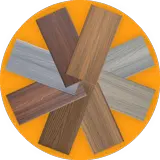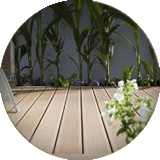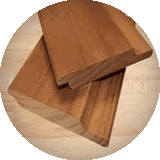Plastic wood compounds
wpc 0 – Soft heat polymers (PE, PP, PVC, etc., fresh or recycled)
Polyethylene (PE)
Polyethylene with the English name Polyethylene and the abbreviation PE is the simplest and most widely used polymer available.
it is resistant to chemicals and has a high electrical resistance, so polyethylene is an excellent insulator.
Therefore, polyethylene is used to insulate electrical wires and cables and many electrical materials. It is a good thermal insulator but has a low melting temperature (106-130 degrees Celsius due to its specific mass). There are three types of commercial polyethylene that differ in molecular structure and density. These three types of polyethylene are: Low Density Polyethylene (LDPE), Medium Density Polyethylene (MDPE) and High Density Polyethylene.
Polypropylene (PP)
Polypropylene has a microscopic branched chemical structure. This structure is mainly chemical properties and other properties
Determines polypropylene. In recent years, the use of polypropylene due to the structural order and sufficient strength and rigidity, higher temperature range and more gloss, high impact resistance, good electrical properties, high durability against acids, bases and salts compared to poly Ethylene has increased.
But the disadvantage of polypropylene is that it is more brittle than polyethylene, especially at low temperatures when it is stiff and difficult to make a screw or nail connection on. Polypropylene is divided into two categories, hemopolymers and copolymers. Hemopolymers are more crystalline and their melting point is 165-161 °C. The melting temperature of couplings is 155-140 °C.
Polyvinyl chloride (PVC)
Polyvinyl chloride (PVC) is made from vinyl chloride monomer. There are two major types of PVC: rigid (non-flexible) and soft (flexible). This polymer begins to melt at 160 °C. An important property of PVC is the flame retardant properties. HCL gas is produced when PVC burns. This gas is heavier than air and therefore extinguishes the flame by depriving it of oxygen. PVC has a higher density compared to polyethylene and polypropylene, but its main disadvantage is its thermal instability and high fragility.
– Wood flour or other lignocellulosic and mineral materials (fillers)
Fillers (reinforcers) are divided into two categories:
organic fillers including flour, wood fibers, agricultural wastes, wastes from various types of paper and mineral fillers including talc, calcium carbonate, clay and synthetic fibers of glass fibers, carbon fibers and aramid.
In the meantime, mineral fillers, which were mostly used in the beginning, significantly improved the mechanical properties of the composite; but with the advancement of science and knowledge of organic fillers due to low cost, low density, high filler capacity, access to various types of fibers around the world, biological degradability in nature, low thermal expansion coefficient, renewable, non-abrasive machinery.
Moreover the non-production of toxic substances after burning replaced mineral fillers. Therefore, with the introduction of cellulose fibers and fillers into the plastic wood industry, wood composites, which include wood fibers or other lignocellulosic materials as fillers or reinforcements and thermoplastics, were born.

– Additives (couplings, lubricants, foaming agents, stabilizers, fire retardants, anti-destructive materials, etc.)
In the process of making plastic wood, in addition to the main raw materials, other compounds are generally used up to 1 to 10%, which are called additives. Additives are important components in the formulation of plastic wood composites that play a key role in processability, in-process stability, flow rate, surface smoothness of the part, as well as its mechanical properties, durability and functionality.
Additives include many categories and different chemical compounds that are used to provide various properties such as modification of mechanical properties, stabilization and facilitation of plastic wood plasticity.
Although the consumption of additives in plastic wood formulation is low, but the same amount has a major impact on processability, mechanical properties as well as the cost of the product. Depending on the type of polymer used and the final use of plastic wood, the amount and percentage of additives used varies. The presence of some additives is required to produce plastic wood products.








